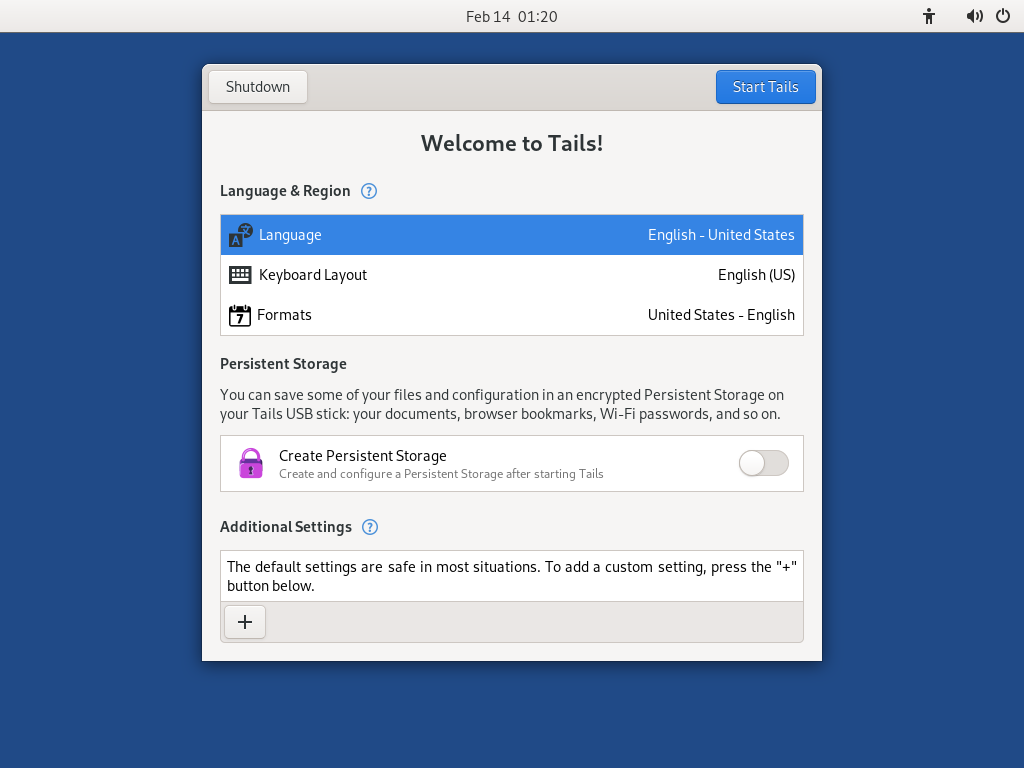- install
- Install Tails from Debian or Ubuntu using the command line and GnuPG
You need
1 USB stick
Only for Tails!
8 GB minimum
Your Tails
1 USB stick
All data will be lost!
8 GB minimum
Windows 7
or later
macOS 10.10
Yosemite
or later
Linux
any distribution
Debian
Ubuntu
or another derivative
Another Tails
USB stick or DVD
Intel processor
not Apple M1 or M2
Smartphone
or printer
to follow the instructions
1 hour in total
½ hour
¼ hour
1.4 GB to download
½ hour to install
½ hour to upgrade
Detailed system requirements and recommended hardware.
Summary
Tails works on:
- Most PC computers that are less than 10 years old
- Some older Mac computers with an Intel processor
Tails does not work:
- Newer Mac computers with an Apple processor (M1 or M2)
- Smartphones or tablets
- Raspberry Pi
Tails might not work on:
Some older computers, for example, if they don't have 2 GB of RAM.
Some newer computers, for example, if their graphics card is incompatible with Linux. Nvidia or AMD Radeon cards often do not work in Tails.
See our list of known hardware compatibility issues.
Detailed hardware requirements
A USB stick of 8 GB minimum or a recordable DVD.
All the data on this USB stick or DVD is lost when installing Tails.
The ability to start from a USB stick or a DVD reader.
A 64-bit x86-64 IBM PC compatible processor.
2 GB of RAM to work smoothly.
Tails can work with less than 2 GB RAM but might behave strangely or crash.
Recommended hardware
Laptop models evolve too rapidly for us to be able to provide an up-to-date list of recommended hardware. Below are some guidelines if you, or your organization, are considering acquiring a laptop dedicated to running Tails.
For PC
Avoid "gaming" models with Nvidia or AMD Radeon graphics cards.
Consider buying a refurbished laptop from a high-end (professional) series. These are cheaper and will last longer than new but lower-quality laptops.
For example, the Lenovo ThinkPad series work well with Tails, including the X250, X1 Carbon, T440, T480, and T490 models.
If you live in a part of the world where buying refurbished laptops is uncommon, look on eBay and Amazon. Amazon offers a 90-day Amazon Renewed Guarantee.
Consider buying a new laptop from vendors who guarantee the compatibility with Linux and Tails like ThinkPenguin.
For Mac
Unfortunately, we don't know of any Mac model that works well in Tails and can run the latest macOS version.
Your steps

Download Tails

Download Tails

Download the upgrade

Verify your download

Verify your download

Verify your download

Restart on the other Tails
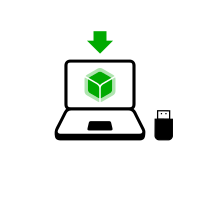
Download balenaEtcher
Install balenaEtcher

Download balenaEtcher
Install balenaEtcher
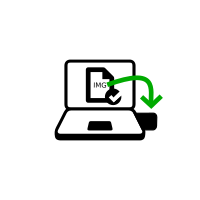
Install Tails using balenaEtcher
Install Tails using GNOME Disks
Install Tails using dd
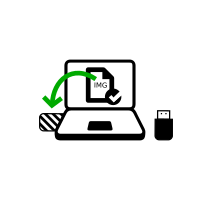
Install intermediary using balenaEtcher

Install intermediary using GNOME Disks

Install intermediary using GNOME Disks

Restart on your Tails USB stick

Restart on intermediary

Restart on intermediary
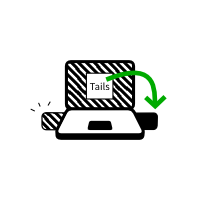
Install Tails by cloning

Upgrade your Tails by cloning
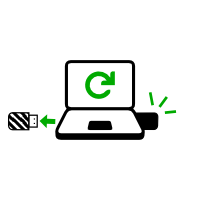
Restart on your new Tails

Welcome to Tails!
Warnings: Tails is safe but not magic!
Tails is safer than any regular operating system. But Tails, or any software or operating system, cannot protect you from everything—even if they pretend to.
The recommendations below will keep you even safer, especially if you are at high risk.
Protecting your identity when using Tails

Tails is designed to hide your identity.
But some of your activities could reveal your identity:
- Sharing files with metadata, such as date, time, location, and device information
- Using Tails for more than one purpose at a time
Limitations of the Tor network

Tails uses the Tor network because it is the strongest and most popular network to protect from surveillance and censorship.
But Tor has limitations if you are concerned about:
- Hiding that you are using Tor and Tails
- Protecting your online communications from determined, skilled attackers
Reducing risks when using untrusted computers

Tails can safely run on a computer that has a virus.
But Tails cannot always protect you when:
- Installing from an infected computer
- Running Tails on a computer with a compromised BIOS, firmware, or hardware
Because you always have to adapt your digital security practices to your specific needs and threats, we encourage you to learn more by reading the following guides:
Verify the Tails signing key
If you already certified the Tails signing key with your own key, you can skip this step and start downloading and verifying the USB image.
In this step, you will download and verify the Tails signing key which is the OpenPGP key that is used to cryptographically sign the Tails USB image.
To follow these instructions you need to have your own OpenPGP key.
To learn how to create yourself an OpenPGP key, see Managing OpenPGP Keys by Riseup.
This verification technique uses the OpenPGP Web of Trust and the certification made by official Debian developers on the Tails signing key.
Import the Tails signing key in your GnuPG keyring:
wget https://tails.net/tails-signing.key
gpg --import < tails-signing.key
Install the Debian keyring. It contains the OpenPGP keys of all Debian developers:
sudo apt update && sudo apt install debian-keyring
Import the OpenPGP key of Chris Lamb, a former Debian Project Leader, from the Debian keyring into your keyring:
gpg --keyring=/usr/share/keyrings/debian-keyring.gpg --export chris@chris-lamb.co.uk | gpg --import
Verify the certifications made on the Tails signing key:
gpg --keyid-format 0xlong --check-sigs A490D0F4D311A4153E2BB7CADBB802B258ACD84F
In the output of this command, look for the following line:
sig!2 0x1E953E27D4311E58 2020-03-19 Chris Lamb <chris@chris-lamb.co.uk>Here,
sig!2means that Chris Lamb verified and certified the Tails signing key with his key and a level 2 check.It is also possible to verify the certifications made by other people. Their name and email address appear in the list of certification if you have their key in your keyring.
If the verification of the certification failed, then you might have downloaded a malicious version of the Tails signing key or our instructions might be outdated. Please get in touch with us.
The line
175 signatures not checked due to missing keysor similar refers to the certifications (also called signatures) made by other public keys that are not in your keyring. This is not a problem.Certify the Tails signing key with your own key:
gpg --lsign-key A490D0F4D311A4153E2BB7CADBB802B258ACD84F
Download Tails

Download the USB image:
wget --continue https://download.tails.net/tails/stable/tails-amd64-6.5/tails-amd64-6.5.img
Verify your download

In this step, you will verify your download using the Tails signing key.
Download the signature of the USB image:
wget https://tails.net/torrents/files/tails-amd64-6.5.img.sig
Verify that the USB image is signed by the Tails signing key:
TZ=UTC gpg --no-options --keyid-format long --verify tails-amd64-6.5.img.sig tails-amd64-6.5.img
The output of this command should be the following:
gpg: Signature made Mon Jul 15 15:41:00 2024 UTC
gpg: using EDDSA key ADA2EDA956C296A70A6D7FF4FE2C600D5BB759B5
gpg: Good signature from "Tails developers (offline long-term identity key) <tails@boum.org>" [full]
gpg: aka "Tails developers <tails@boum.org>" [full]
Verify in this output that:
The date of the signature is the same.
The signature is marked as
Good signaturesince you certified the Tails signing key with your own key.
Install Tails using dd

Make sure that the USB stick on which you want to install Tails is unplugged.
Execute the following command:
ls -1 /dev/sd?
It returns a list of the storage devices on the system. For example:
dev/sdaPlug in the USB stick on which you want to install Tails.
All the data on this USB stick will be lost.
Execute again the same command:
ls -1 /dev/sd?
Your USB stick appears as a new device in the list.
/dev/sda /dev/sdbTake note of the device name of your USB stick.
In this example, the device name of the USB stick is
/dev/sdb. Yours might be different.If you are unsure about the device name, you should stop proceeding or you risk overwriting any hard disk on the system.
Execute the following commands to copy the USB image that you downloaded earlier to the USB stick.
Replace:
tails.img with the path to the USB image
device with the device name found in step 5
dd if=tails.img of=device bs=16M oflag=direct status=progress
You should get something like this:
dd if=/home/user/tails-amd64-3.12.img of=/dev/sdb bs=16M oflag=direct status=progress
If no error message is returned, Tails is being copied on the USB stick. The copy takes some time, generally a few minutes.
If you get a
Permission deniederror, try addingsudoat the beginning of the command:sudo dd if=tails.img of=device bs=16M oflag=direct status=progress
The installation is complete after the command prompt reappears.
Well done!
You have installed Tails on your USB stick.
In the next step, you will make your computer start on this USB stick.
Tails might not work on your computer, so good luck!
If you already started on the other Tails, go directly to step 3: Verify that the other Tails is up-to-date.
Open these instructions on another device

In the next step, you will shut down the computer. To be able to follow the rest of the instructions afterwards, you can either:
Scan this QR code on your smartphone or tablet:











Print these instructions on paper.
Take note of the URL of this page:
https://tails.net/install/windows?back=1
https://tails.net/install/mac?back=1
https://tails.net/install/linux?back=1
https://tails.net/install/expert?back=1
https://tails.net/install/clone/pc?back=1
https://tails.net/install/clone/mac?back=1
https://tails.net/upgrade/tails?back=1
https://tails.net/upgrade/windows?back=1
https://tails.net/upgrade/mac?back=1
https://tails.net/upgrade/linux?back=1
https://tails.net/upgrade/clone?back=1
Restart on the intermediary Tails
Restart on the other Tails
Restart on your Tails USB stick



Make the computer start on the USB stick
-
Make sure that you have installed Tails using either:
Click on the button.
Press and hold the Shift key while you choose Power ▸ Restart.
In the Choose an option screen, choose Use a device.
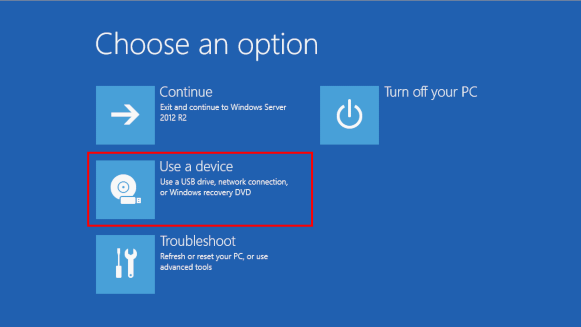
If the Choose an option screen or the Use a device option don't appear, refer to the instructions on starting Tails using the Boot Menu key.
In the Use a device screen, choose Boot Menu.
Windows shuts down, the computer restarts, and a Boot Menu appears.
Plug in your Tails USB stick shortly after choosing Boot Menu and while Windows is shutting down.
If your Windows has no Boot Menu option available, make sure that your Tails USB stick is plugged in and choose your USB stick directly in the list of devices.
In the future, we We recommend that you only plug in your Tails USB stick while Windows is shutting down. Otherwise, a virus in Windows could infect your Tails USB stick and break its security.
Such an attack is possible in theory but very unlikely in practice. We don't know of any virus capable of infecting Tails. See our warning on plugging Tails in untrusted systems.
The Boot Menu is a list of possible devices to start from. The following screenshot is an example of a Boot Menu:
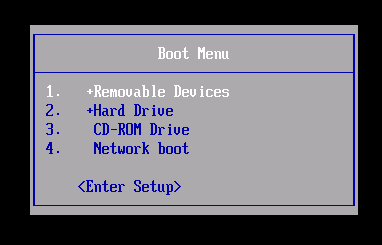
In the Boot Menu, select your USB stick and press Enter.
If the computer starts on Tails, the Boot Loader appears and Tails starts automatically after 4 seconds.
The Troubleshooting Mode entry disables some features of the Linux kernel and might work better on some computers. You can try this option if you think you are experiencing hardware compatibility errors while starting Tails.
The External Hard Disk entry makes it possible to start from an external hard disk and some problematic USB sticks.
Most computers do not start on the Tails USB stick automatically but you can press a Boot Menu key to display a list of possible devices to start from.
If Windows 8 or 10 is also installed on the computer, you can refer instead to the instructions on starting Tails from Windows 8 or 10. Starting Tails from Windows is easier than using the Boot Menu key.
The following screenshot is an example of a Boot Menu:

This animation summarizes how to use the Boot Menu key to start on the USB stick:
The following instructions explain in detail how to use the Boot Menu key to start on the USB stick:
-
Make sure that you have installed Tails using either:
-
Shut down the computer while leaving the USB stick plugged in.
Shut down the computer and plug in the Tails USB stick.
Shut down the computer.
Plug in the other Tails USB stick that you want to install upgrade from.
Unplug your Tails USB stick while leaving the intermediary USB stick plugged in.
-
Identify the possible Boot Menu keys for the computer depending on the computer manufacturer in the following list:
Manufacturer Key Acer F12, F9, F2, Esc Apple Option Asus Esc Clevo F7 Dell F12 Fujitsu F12, Esc HP F9 Huawei F12 Intel F10 Lenovo F12, Novo MSI F11 Samsung Esc, F12, F2 Sony F11, Esc, F10 Toshiba F12 Others… F12, Esc On many computers, a message is displayed very briefly when switching on that also explains how to get to the Boot Menu or edit the BIOS settings.
-
Schalten Sie den Computer ein.
Immediately press several times the first possible Boot Menu key identified in step 2.
-
If the computer starts on another operating system or returns an error message, shut down the computer again and repeat step 3 for all the possible Boot Menu keys identified in step 2.
If a Boot Menu with a list of devices appears, select your USB stick and press Enter.
If the computer starts on Tails, the Boot Loader appears and Tails starts automatically after 4 seconds.
-
Make sure that you have installed Tails using either:
-
Shut down the computer.
Shut down the computer while leaving the USB stick plugged in.
Plug in the other Tails USB stick that you want to install from.
-
Plug in your Tails USB stick.
-
Switch on the computer.
Immediately press-and-hold the Option key (⌥ or Alt key) when the startup sound is played.
Hold the key pressed until a list of possible startup disks appears.
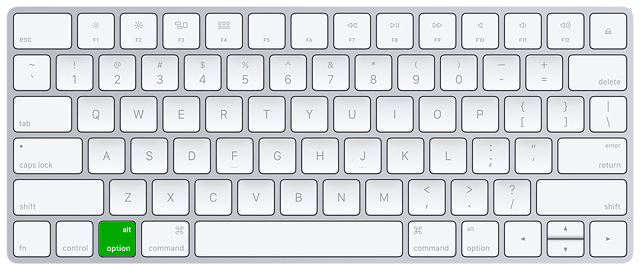
-
Choose the USB stick and press Enter. The USB stick appears as an external hard disk and might be labeled EFI Boot or Windows like in the following screenshot:
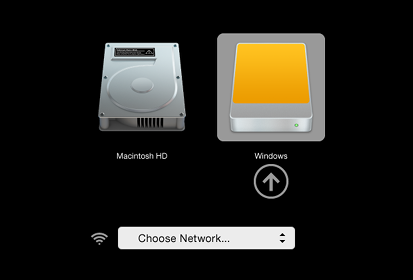
If the USB stick does not appear in the list of startup disks:
Wait 2–3 minutes and try again. Some USB sticks need some rest after installing.
Try all other USB ports on the computer. Some USB ports cannot be used to start from.
Make sure that you have installed Tails using either:
Make sure that you have verified your download of Tails.
Make sure that you have verified your download.
-
Try to install again on the same USB stick.
Try to install again on the same USB stick.
Try to install again on the same USB stick.
Try to install again on the same USB stick.
Try to install again on the same USB stick.
Try to install again on the same USB stick.
Try to install again on the same USB stick.
Try to install again on the same USB stick.
Try to install again on the same USB stick.
Try to install again on the same USB stick.
Try to install again on the same USB stick.
Try to install again on the same USB stick.
Try to install on a different USB stick.
Try to use the same USB stick to start on a different computer.
If your computer still does not display the Boot Loader, it might currently be impossible to start Tails on your computer.
-
If your Mac displays the following error:
Security settings do not allow this Mac to use an external startup disk.
Then you have to change the settings of the Startup Security Utility of your Mac to authorize starting from Tails.
To open Startup Security Utility:
Turn on your Mac, then press and hold Command(⌘)+R immediately after you see the Apple logo. Your Mac starts up from macOS Recovery.
When you see the macOS Utilities window, choose Utilities ▸ Startup Security Utility from the menu bar.
When you are asked to authenticate, click Enter macOS Password, then choose an administrator account and enter its password.
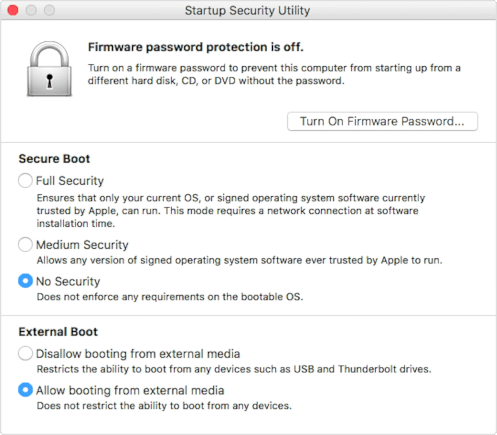
In the Startup Security Utility:
Choose No Security in the Secure Boot section.
Choose Allow booting from external media in the External Boot.
To still protect your Mac from starting on untrusted external media, you can set a firmware password, available on macOS Mountain Lion or later. A firmware password prevents users who do not have the password from starting up from any media other than the designated startup disk.
If you forget your firmware password you will require an in-person service appointment with an Apple Store or Apple Authorized Service Provider.
Read more on Apple Support about:
If the computer starts on Tails, the Boot Loader appears and Tails starts automatically after 4 seconds.
The Troubleshooting Mode entry disables some features of the Linux kernel and might work better on some computers. You can try this option if you think you are experiencing hardware compatibility errors while starting Tails.
The External Hard Disk entry makes it possible to start from an external hard disk and some problematic USB sticks.
Troubleshoot Tails not starting
-
If no Boot Menu appears, refer to the instructions on starting Tails using the Boot Menu key.
-
If none of the possible Boot Menu keys from the previous technique work, refer to the troubleshooting instructions about Tails not starting at all.
-
If the Boot Menu appears but your USB stick is not listed in the Boot Menu:
Wait 2–3 minutes and try again. Some USB sticks need some rest after installing.
Try all other USB ports on the computer. Some USB ports cannot be used to start from.
-
If your USB stick is listed in the Boot Menu but the Boot Loader does not appear:
If your USB stick appears in the list of startup disks but the Boot Loader does not appear:
Wait 2–3 minutes and try again. Some USB sticks need some rest after installing.
Try all other USB ports on the computer. Some USB ports cannot be used to start from.
Make sure that you have installed Tails using either:
Make sure that you have verified your download of Tails.
Make sure that you have verified your download.
-
Try to install again on the same USB stick.
Try to install again on the same USB stick.
Try to install again on the same USB stick.
Try to install again on the same USB stick.
Try to install again on the same USB stick.
Try to install again on the same USB stick.
Try to install again on the same USB stick.
Try to install again on the same USB stick.
Try to install again on the same USB stick.
Try to install again on the same USB stick.
Try to install again on the same USB stick.
Try to install again on the same USB stick.
Try to install on a different USB stick.
Try to use the same USB stick to start on a different computer.
If your computer still does not display the Boot Loader, it might currently be impossible to start Tails on your computer.
-
If the Boot Loader appears but Tails fails to start after the Boot Loader, refer to the troubleshooting section about Tails not starting after the Boot Loader. the troubleshooting section about Tails not starting after the Boot Loader.
Starting the computer using a Boot Menu key can be faster than starting the computer on Windows first and then on Tails. We recommend you learn how to start Tails using the Boot Menu key if you use Tails regularly.
Apple does not prioritize collaborating with Free Software projects. Their newest hardware is usually very hard for Free Software developers to get working with Linux, and thus Tails. PC hardware tends to be more open and work better with Linux.
Welcome to Tails!

Starting Tails

After the Boot Menu, a loading screen appears.

One to two minutes after the Boot Loader and the loading screen, the Welcome Screen appears.
In the Welcome Screen, select your language and keyboard layout in the Language and Formats section. Click Start Tails.
If your keyboard or touchpad doesn't work, try using a USB keyboard or mouse.
After 15–30 seconds, the Tails desktop appears.
Welcome to your new Tails!

You made it!
You managed to start your new Tails on your computer!
Congratulations on staying safe :)
To continue discovering Tails, read our documentation.
Test your Wi-Fi
Problems with Wi-Fi are unfortunately quite common in Tails and Linux in general. To test if your Wi-Fi interface works in Tails:
Open the system menu in the top-right corner:

Choose Wi-Fi Not Connected and then Select Network.
After establishing a connection to a local network, the Tor Connection assistant appears to help you connect to the Tor network.
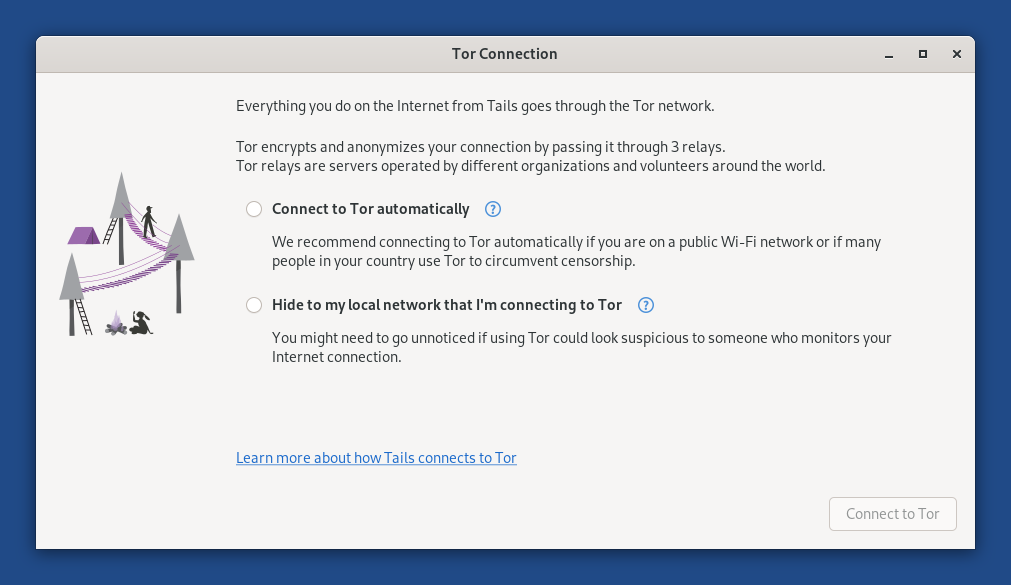
If your Wi-Fi interface is not working, you might experience the following:
There is no Wi-Fi menu in the system menu:
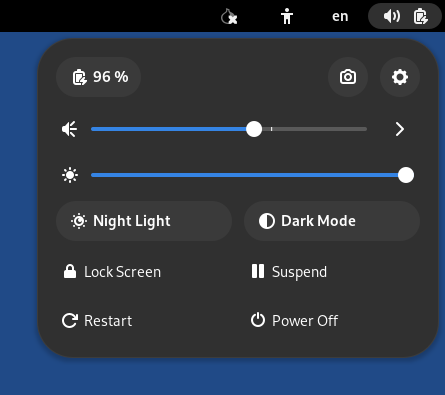
The interface is disabled because MAC address anonymization failed:
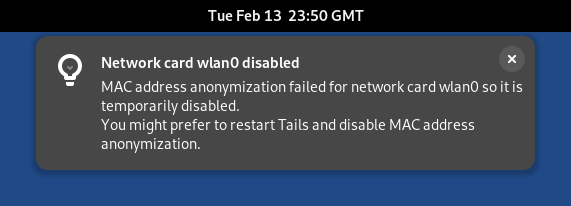
In this case, you can disable MAC address anonymization in the Welcome Screen. Doing so has security implications, so read carefully our documentation about MAC address anonymization.
The following notification appears:
Activation of network connection failed
To connect to the Internet, you can try to:
Use an Ethernet cable instead of Wi-Fi if possible. Wired interfaces work much more reliably than Wi-Fi in Tails.
Share the Wi-Fi or mobile data connection of your phone using a USB cable. Sharing a connection this way is called USB tethering.

See instructions for:
-
Only sharing mobile data works on iPhones and iPads; sharing Wi-Fi does not work.
Tails cannot hide the information that identifies your phone on the local network. If you connect your phone to a:
Wi-Fi network: the network can see the MAC address of your phone.
This has security implications that we explain in our documentation on MAC address anonymization. Some phones have a feature to hide the MAC address of the phone.
Mobile data network: the network is able to know the identifier of your SIM card (IMSI) and the serial number of your phone (IMEI).
-
Buy a USB Wi-Fi adapter that works in Tails:
Vendor Model Size Speed Price Buy offline Buy online Panda Wireless Ultra Nano 150 Mbit/s $18 No Amazon Panda Wireless PAU05 Small 300 Mbit/s $65 No Amazon ThinkPenguin TPE-N150USB Nano 150 Mbit/s $74 No ThinkPenguin If you find another USB Wi-Fi adapter that works in Tails, please let us know. You can write to tails-support-private@boum.org (private email).
Check in our list of known Wi-Fi issues if there is a workaround to get your Wi-Fi interface to work in Tails.



